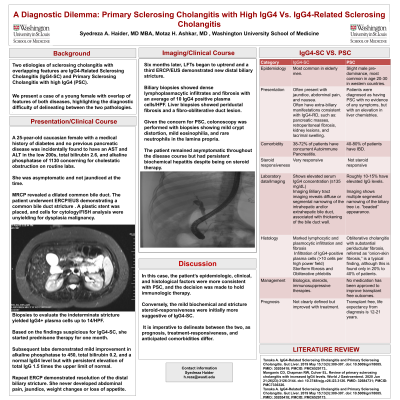Back


Poster Session B - Monday Morning
Category: Biliary/Pancreas
B0064 - A Diagnostic Dilemma: Primary Sclerosing Cholangitis With High IgG4 vs IgG4-Related Sclerosing Cholangitis
Monday, October 24, 2022
10:00 AM – 12:00 PM ET
Location: Crown Ballroom

Has Audio
.jpg)
Syedreza A. Haider, MD
Barnes Jewish Hospital at Washington University in St. Louis
St Louis, MO
Presenting Author(s)
Syedreza A. Haider, MD1, Motaz Ashkar, MD, MSCI2
1Barnes Jewish Hospital at Washington University in St. Louis, St. Louis, MO; 2Washington University in St. Louis School of Medicine, St. Louis, MO
Introduction: Two etiologies of sclerosing cholangitis with overlapping features are Type 2 IgG4-Related Sclerosing Cholangitis (IgG4-SC) and Primary Sclerosing Cholangitis with high IgG4 (PSC). Here, we present a complex case of a young patient with features of both diseases.
Case Description/Methods: A 25-year-old Caucasian female with a medical history of diabetes and no previous pancreatic disease was incidentally found to have an AST and ALT in the low 200s, total bilirubin 2.6, and alkaline phosphatase of 1130 concerning for cholestatic obstruction. She was asymptomatic and not jaundiced at the time. Subsequent MRCP revealed a dilated common bile duct. The patient underwent ERCP/EUS demonstrating a common bile duct stricture. A plastic stent was placed, and cells for cytology/FISH analysis were unyielding for malignancy. Repeat ERCP/EUS was performed a few months later for stent exchange. Biopsies to evaluate the indeterminate stricture yielded IgG4+ plasma cells up to 14/HPF. Based on the findings suspicious for IgG4-SC, she started prednisone therapy for one month. Subsequent labs demonstrated mild improvement in alkaline phosphatase to 450, total bilirubin 0.2, and a normal IgG4 level but with persistent elevation of total IgG 1.5 times the upper limit of normal. Repeat ERCP demonstrated resolution of the distal biliary stricture. She never developed abdominal pain, jaundice, weight changes or loss of appetite. Six months later, LFTs began to uptrend and a third ERCP/EUS demonstrated new distal biliary stricture. Biliary biopsies showed dense lymphoplasmacytic infiltrates and fibrosis with an average of 10 IgG4 positive plasma cells/HPF. Liver biopsies showed periductal fibrosis and a fibro-obliterative duct lesion. Given the concern for PSC, colonoscopy was performed with biopsies showing mild crypt distortion, mild eosinophilia, and rare neutrophils in the lamina propria. The patient remained asymptomatic throughout the disease course but had persistent biochemical hepatitis despite being on steroid therapy. A shared provider-patient decision was made to withhold immunosuppressive or biologic therapy.
Discussion: In this case, the patient’s epidemiologic, clinical, and histological factors were more consistent with PSC. Conversely, the mild biochemical and stricture steroid-responsiveness were initially more suggestive of IgG4-SC. It is imperative to delineate between the two, as prognosis, treatment-responsiveness, and anticipated comorbidities differ.
Disclosures:
Syedreza A. Haider, MD1, Motaz Ashkar, MD, MSCI2. B0064 - A Diagnostic Dilemma: Primary Sclerosing Cholangitis With High IgG4 vs IgG4-Related Sclerosing Cholangitis, ACG 2022 Annual Scientific Meeting Abstracts. Charlotte, NC: American College of Gastroenterology.
1Barnes Jewish Hospital at Washington University in St. Louis, St. Louis, MO; 2Washington University in St. Louis School of Medicine, St. Louis, MO
Introduction: Two etiologies of sclerosing cholangitis with overlapping features are Type 2 IgG4-Related Sclerosing Cholangitis (IgG4-SC) and Primary Sclerosing Cholangitis with high IgG4 (PSC). Here, we present a complex case of a young patient with features of both diseases.
Case Description/Methods: A 25-year-old Caucasian female with a medical history of diabetes and no previous pancreatic disease was incidentally found to have an AST and ALT in the low 200s, total bilirubin 2.6, and alkaline phosphatase of 1130 concerning for cholestatic obstruction. She was asymptomatic and not jaundiced at the time. Subsequent MRCP revealed a dilated common bile duct. The patient underwent ERCP/EUS demonstrating a common bile duct stricture. A plastic stent was placed, and cells for cytology/FISH analysis were unyielding for malignancy. Repeat ERCP/EUS was performed a few months later for stent exchange. Biopsies to evaluate the indeterminate stricture yielded IgG4+ plasma cells up to 14/HPF. Based on the findings suspicious for IgG4-SC, she started prednisone therapy for one month. Subsequent labs demonstrated mild improvement in alkaline phosphatase to 450, total bilirubin 0.2, and a normal IgG4 level but with persistent elevation of total IgG 1.5 times the upper limit of normal. Repeat ERCP demonstrated resolution of the distal biliary stricture. She never developed abdominal pain, jaundice, weight changes or loss of appetite. Six months later, LFTs began to uptrend and a third ERCP/EUS demonstrated new distal biliary stricture. Biliary biopsies showed dense lymphoplasmacytic infiltrates and fibrosis with an average of 10 IgG4 positive plasma cells/HPF. Liver biopsies showed periductal fibrosis and a fibro-obliterative duct lesion. Given the concern for PSC, colonoscopy was performed with biopsies showing mild crypt distortion, mild eosinophilia, and rare neutrophils in the lamina propria. The patient remained asymptomatic throughout the disease course but had persistent biochemical hepatitis despite being on steroid therapy. A shared provider-patient decision was made to withhold immunosuppressive or biologic therapy.
Discussion: In this case, the patient’s epidemiologic, clinical, and histological factors were more consistent with PSC. Conversely, the mild biochemical and stricture steroid-responsiveness were initially more suggestive of IgG4-SC. It is imperative to delineate between the two, as prognosis, treatment-responsiveness, and anticipated comorbidities differ.
Disclosures:
Syedreza Haider indicated no relevant financial relationships.
Motaz Ashkar indicated no relevant financial relationships.
Syedreza A. Haider, MD1, Motaz Ashkar, MD, MSCI2. B0064 - A Diagnostic Dilemma: Primary Sclerosing Cholangitis With High IgG4 vs IgG4-Related Sclerosing Cholangitis, ACG 2022 Annual Scientific Meeting Abstracts. Charlotte, NC: American College of Gastroenterology.
